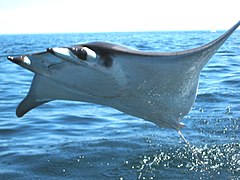| Mobula | |
|---|---|

| |
| Mobula sp breaching, Baja California | |
| Scientific classification | |
| Domain: | Eukaryota |
| Kingdom: | Animalia |
| Phylum: | Chordata |
| Class: | Chondrichthyes |
| Subclass: | Elasmobranchii |
| Order: | Myliobatiformes |
| Family: | Mobulidae |
| Genus: | Mobula Rafinesque, 1810 |
| Type species | |
| Raja mobular Bonnaterre, 1788
| |
Mobula is a genus of rays in the family Mobulidae that is found worldwide in tropical and warm, temperate seas.[3] Some authorities consider this to be a subfamily of the Myliobatidae (eagle rays).[4][5] Their appearance is similar to that of manta rays, which are in the same family, and based on genetic and morphological evidence, the mantas belong in Mobula (they are traditionally in their own genus Manta).[3]
Species of this genus are often collectively referred to as "devil rays", "flying mobula", or simply "flying rays", due to their propensity for breaching, sometimes in a spectacular manner. These rays gather in groups and leap out of the surface into the air up to around two metres before splashing back into the water.[6]
| External videos | |
|---|---|
- ^ Sepkoski, Jack (2002). "A compendium of fossil marine animal genera (Chondrichthyes entry)". Bulletins of American Paleontology. 364: 560. Archived from the original on 10 May 2012. Retrieved 9 January 2008.
- ^ "Appendices". CITES. Retrieved 14 January 2022.
- ^ a b White; Corrigan; Yang; Henderson; Bazinet; Swofford; Naylor (2017). "Phylogeny of the manta and devilrays (Chondrichthyes: mobulidae), with an updated taxonomic arrangement for the family". Zoological Journal of the Linnean Society. 182: 50–75. doi:10.1093/zoolinnean/zlx018.
- ^ Nelson, J.S. (2006). Fishes of the World (4 ed.). John Wiley & Sons.
- ^ Froese, Rainer; Pauly, Daniel (eds.). "Species in genus Mobula". FishBase. July 2017 version.
- ^ Pavid, Katie (n.d.). "The spectacular display of the mobula ray". Natural History Museum. The Trustees of The Natural History Museum, London. Retrieved 25 September 2022.